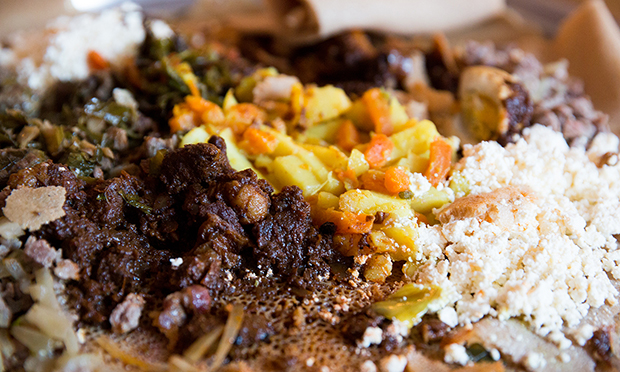Having an Ethiopian feast in Hackney
The Beatles said it all: John, Paul, Ringo and George inadvertently gave a name to the first near-human in history. In 1974 anthropologists who located and reconstructed the female skeleton of a hominid who lived over three million years ago, rejoiced, in their encampment in Hadar in the Awash Valley, to a euphoric tape of ‘Lucy in the Sky with Diamonds’; hence her name. Our Lucy, Australopithecus afarensis, had her origins in Ethiopia all those years ago, while Hackney citizens were mere blobs of ectoplasm in the primeval ooze of stream and swamp.
Later the great kingdom of Ethiopia, with its unparalleled wealth, its powerful rulers, magnificent scenery and amazing natural resources, was renowned for its jewels and rare perfumes. A sophisticated cuisine evolved to match this splendour, and even now, despite the tangled politics of its recent past, a search for Ethiopian food is for us an insight into a strange and wonderful history.
Pearl of great price
This cuisine is so far beneath the radar of ‘fine dining’ that it’s hard to locate all the places in Hackney where it can be sampled, but once you know what to look for, there is much to enjoy. The foundation of an Ethiopian meal is injera, a wondrous thing that is probably the most visually unprepossessing food ever invented, a sludge-coloured, floppy, slightly clammy pancake, with a porous sponge-like texture, but enough tensile strength and pliability to act as wrap, shovel, spoon and mopper-upper.
A batter is made from the fermented dough of a flour made from teff, the seed of a grass found only in Ethiopia and Eritrea, which is cooked on a metal disk about 50cm across. This forms the base on which the components of a meal are served; the various items are plonked on this absorbent layer, which soaks up the juices, and can also be torn into receptacles for mouthfuls of the different thick stews, wat, or zigni. Injera is nutritionally a pearl of great price, with no gluten whatsoever, but an impressive range of amino acids, vitamins, calcium, minerals, protein, carbohydrates and fibre. Its enigmatic flavour, due to days of fermentation, is neither sour nor acid, but has a distinct tang, a tasty catalyst for the flavour of the spicy meat and vegetables that are eaten with it.
Spice and veg
Vegetables are not mere ‘sides’ but an important item in the diet of the main Ethiopian religions, which have many non-meat days in the year. So vegetable stews are complex and delicious, holding their own with the meaty ones. Dried pulses and lentils, often spiced as they are dried, are cooked in rich dishes, with more flavouring from one of the many different spice mixtures. Spinach or chard is often combined with lentils, cabbage gets a crisp pungency. Sometimes cheese is added, but every vegetable dish has its distinct characteristics.
The spice mixtures used in Ethiopian cuisine are not dissimilar to North Africa and the Middle East, but have their own distinct personalities, mainly from the use of certain items like fenugreek and a rare kind of cardamom, and of course chilli, but with moderation; berbere spice powder is one of the best known, or awaze, a red chilli paste. You could use harissa, or some of the Turkish tomato and chilli pastes, but the effect is not quite the same. Here is a tired woman in a hurry’s cheat:
Zigni Wat
400g good quality minced beef
2 or 3 red onions, peeled and chopped
2 tablespoons of Turkish chilli
and red pepper paste
fenugreek, cardamom and
black cumin ground together
ginger, chopped
garlic, chopped
spiced butter
salt to taste
Cook the onion slowly in a heavy bottomed pan until soft and just changing colour. Add the ginger and garlic, then the spice paste and the ground spices. Put in a little water and stir well. Then put in the meat and cook gently until done.
But there are two other factors: the ‘dry’ cooking of ingredients at the start of preparation, where onions, peeled and finely chopped, are cooked slowly without water or fat, until soft and slightly coloured, and then added to the rest of the ingredients. Meat too, is given the same treatment. Unctuousness and flavour are imparted by another magical element, spiced butter, which is added as a flavouring in the course of cooking, not used as a frying medium. Clarified butter is simmered with ginger, garlic and chopped red onion, and a mixture of herbs and spices, then cooled and strained. Again, there is no substitute for this, but it doesn’t take too long
to do.

